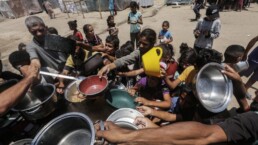The state of hunger in Gaza has not ended. Its long-term health effects are starting to show.
By Tareq S. Hajjaj, Mondoweiss
Ahmad Abdulrahim, 38, strolled the remains of the markets in Gaza City with 150 Shekels in his pocket, the amount of money he used to feed his family of five for a week before the genocide. Today, that amount can hardly buy a single meal.

The markets, now little more than bombed-out remains, are empty of all basic needs, including vegetables, meat, and fruits. For the majority of people, such luxuries are unavailable except at unimaginable prices. Most vegetables, rare though they are, come from people’s gardens.
All Ahmad could find were cleaning supplies and canned foods. Ahmad told Mondoweiss that due to his children’s long-term dependence on these foods, they’ve started to develop health problems. After a protracted search, Ahmad found some zucchini; he walked faster when he noticed the seller, who had placed them in a small pile on the ground on top of a plastic bag. When he asked about the price, he was surprised to know that one kilogram of zucchini cost 80 Shekels ($20). Before the war, it used to be 3 shekels per kilo (less than a dollar).
Such was the price for most other vegetables that could be found. One kilo of green peppers cost 250 shekels ($66), where it used to be 5 ($1.4). One kilo of cucumber and tomato cost 90-100 shekels ($23-$26), which used to be 2-3 shekels (53-80 cents).
Recent Posts
All Democratic Presidential Candidates In 2028 Should Commit To Dismantling ICE
January 8, 2026
Take Action Now Since its inception, ICE has been designed to conflate issues of immigration with terrorist threats against the U.S.By Sam…
Trump Cuts Billions In Federal Childcare Funds For Democratic-Led States After Minnesota Fraud Scandal
January 8, 2026
Take Action Now Administration cites welfare fraud allegations as advocates and state leaders warn of political retaliation and sweeping harm to…
After The ICE Killing In Minneapolis, Will Truth Prevail?
January 8, 2026
Take Action Now Can Trump and Kristi Noem maintain their blatant lies in the face of multiple videos that show the victim was trying to drive away…
Venezuela And The Long Shadow Of The Monroe Doctrine
January 7, 2026
Take Action Now Critical historians like William Appleman Williams played a key role in highlighting the US’s imperial record in Latin America. Now…




